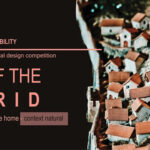Submission: November 19, 2019
Registration: November 01, 2019
Language: English
Location: Concept
Prizes: Please see details below
Type: Open
“The Rio Salado” is a collection of rivers [the White and the Black] that on their way down the mountains east of Phoenix, combine into one. Also known as the Salt, as it makes its way across the Valley floor giving way to the Gila River which is joined a few miles later by the Agua Fria River. It is this convergence that caries what water remains to the Colorado River and finally the Gulf of Mexico.
As with most rivers, The Rio Salado is what made life possible in the Valley, less as a means of transportation, or power generation, but the source of sustenance for agriculture. It’s dramatic swings in the flow – from a trickle to flood, creating ever-changing banks and inconsistent edges, the Rio became as much a line dividing the land than connecting those whose very existence is made possible by its presence. This constant change in flow and the location of the banks gave The Rio an ephemeral quality – enough to the effect that most residents of the Valley refer to it as the Salt River Bed – not the Salt River.
The Salt River Project Utility Cooperative was created in 1903 to manage the river and did so with a series of reservoirs [Roosevelt, Apache, Canyon and Saguaro]. While this management mitigated flooding, it did not eliminate flooding. It is this potential danger, similar to the LA River, that has lead the Valley to look at The Rio not as a source of abundance, but as hazard. In time, with it’s devaluation, the one time gathering spot was either abandoned or used in a manner that reflected that hazard – dumps, gravel pits, industrial facilities, etc.
With limited ability to use or occupy the river bed and added constraint of limited crossings, communities grew around and away from this “scar” until recently. Today, with a new sense of awareness toward our resources, communities all along The Rio’s edge are looking at in in a whole new way. Many are asking, “What can we do to reclaim this forgotten asset?”
THE CROSSINGS
Mesa to SRPMIC | Rio Salado Path + Riverview Park | City to Agriculture
Phoenix to Phoenix | Central Avenue | City to City
Loop 202 South Mtn Freeway | Infrastructure | New Formality to Back Road
PROGRAM + PROMPT
Community focused spaces + infrastructure
Provide a response based on the specific context and circumstance to ‘express an attitude’:
About the Line: as an edge, separation, connection, social, political, economic
About Program: community, permanent, temporary
About Resilience: climate + economics + political + social
About Connecting Communities: visual vs physical connection
REGISTRATION + FEE
Go to AIA Phoenix Metro’s website http://aia-phoenixmetro.org/
Entrants will be assigned an identification number to be used on all documents + digital file naming
$125 entry fee for Non-Members
$100 entry fee for AIA Members and Students (One team member must be a student or AIA member)
SUBMITTAL REQUIREMENTS
One 34” x 44“ vertical board to be used freely to express distinct physical design concept and visual narrative. Supporting information [financial models, sustainability strategies, tectonic innovations] included on the board.
Provide a clear and simple description of observations with proposed idea explaining how prompt was addressed – limited to 500 words – and integrated in to the board.
Board must be mounted on rigid backing and delivered to the AIA Arizona Headquarters 30 North 3rd Ave suite 200, Phoenix, AZ 85003 by 5pm MST, November 19, 2019 with an identical digital submission 150 dpi (PDF or JPEG), sent to the AIA via WeTransfer.com to diana@aia-arizona.org concurrently.
Entrants must not identify themselves in any fashion. Entry numbers, provided upon registration, must be clearly placed upon the board. AIA Phoenix Metro and/or ULI and Arizona Forward may choose all or a portion of the entries for public exhibition at their discretion.
May be an individual or a team. Open to anyone who wishes to enter, except jury members and organizing staff.
AWARDS
(1) First Place Professional Category: $4,000 + publication and exhibition
(2) Finalist Professional Category: $1250 + publication and exhibition
(1) First Place Student Category: $1000 + publication and exhibition
EXPOSURE
The competition is intended to generate ideas to showcase a strong vision for our city. Additional details and publication to be announced later. The results of this competition will inform successive years in this competition series.
JURY
Diane Jacobs, AIA, Principal, Holly Street Studio | Moderator
Michael Blier, FASLA, Principal, Landworks Studio | Chair
Jay Hicks, ASLA, Principal, Dig Studio
Marc Neveu, Head of Architecture, Arizona State University
Milagros Zingoni, Professor of Architecture, Arizona State University
Sam Gomez, Executive Director, The Sagrado
DATES
03 OCT Close of Q+A
08 OCT Q+A Results
18 OCT Registration Deadline
01 NOV Late Registration Deadline
19 NOV Submissions Due 5PM MST
21 NOV Jury Review
21 NOV AIA PHX Metro Annual Event








